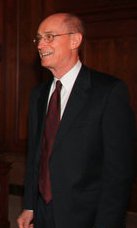First Presidency (Church of Jesus Christ of Latter-day Saints)


The First Presidency or Quorum of the Presidency of the Church or simply the Presidency is the presiding or governing body of The Church of Jesus Christ of Latter-day Saints . It consists of the President of the Church and his two counselors. The First Presidency currently consists of Russell M. Nelson and his two counselors, Dallin H. Oaks and Henry B. Eyring .
membership
The First Presidency consists of the President and his two counselors. However, circumstances sometimes allowed more than two counselors to exist. For example, David O. McKay had five counselors at a time and Brigham Young had eight counselors in the last few years of his presidency .
Counselors must have the priesthood and are usually selected by the Quorum of the Twelve Apostles . However, there have been instances where counselors have been chosen from within the Presiding Bishopric or from across the Church. Each priesthood holder can serve as a counselor. Apostles or not, all members of the First Presidency are sworn in as prophets, seers, and revelators .
Counselors are formally referred to as “First Counselor in the First Presidency” and “Second Counselor in the First Presidency” based on the order in which the President selected them. Other guides have been given different names.
Counselors serve in the First Presidency until they die, until the death of the president who appointed them, or until they are dismissed by the president. The president's death dissolves the First Presidency, and the President of the Quorum of the Twelve Apostles becomes the new President of the Church. The death or dismissal of a counselor does not end the First Presidency.
Often the counselors are taken over by the new president after the president's death, or counselors in poor health move to the Quorum of the Twelve Apostles and vacate the counselor post for healthier successors. After the death or dismissal of the first counselor, the second counselor moves up to his place and a new second counselor is appointed. Although these are common practices, there are no hard and fast rules and the President can choose which counselors he wants.
Titles of members
Like the President of the Church and the President of the Quorum of the Twelve Apostles, members are also called Presidents .
Discharge
Although there is no popular movement within the Church to remove a member of the First Presidency, members can in theory be removed or otherwise punished.
Duties
The First Presidency is the highest priesthood quorum in the Church. The counselors help and work with the President of the Church to lead the whole Church. They also carry out the duties that the President gives them. The First Presidency has the theoretical authority to make the final decision on all issues affecting the Church. In practice, however, the First Presidency gives much of its decision-making power to the Quorum of the Twelve Apostles, the Presiding Bishopric, and other local Church leaders. Even so, the First Presidency has the final say in all decisions affecting the Church and can overrule decisions made by lesser quorums and authorities in the Church.
In the case of a frail president, the counselors can also perform duties that are otherwise intended for the president. You can use as many counselors as you want to help you with this. But the president remains the only person who has all the keys of the priesthood.
All members of the First Presidency also decide how the money raised by tithing will be distributed.
Death of the president
When the President of the Church dies:
- The First Presidency is automatically terminated upon the death of the President.
- First Presidency counselors (if they hold the office of Apostle) restore their places in the Quorum of the Twelve Apostles, in order of seniority. This is determined by the time at which someone was ordained an apostle, not by their age.
- The Quorum of the Twelve Apostles, now (usually) 14 members, takes over the leadership of the Church under the direction of the senior apostle.
- The Quorum of the Twelve Apostles, chaired by the senior apostle, meets to discuss two options: Should the First Presidency be reformed now? Or should the Church initially continue to be under the direction of the Quorum of the Twelve Apostles?
- When this is discussed, a formal request is made and accepted by the Quorum of the Twelve Apostles.
- When a decision is made to establish a new First Presidency, the Quorum of the Twelve Apostles unanimously elect the new President of the Church. The new president usually selects two counselors from the Quorum of the Twelve Apostles; however, he may elect any priesthood holder who holds at least the office of elder . These three now form the new First Presidency. In the succession crisis from 1844 to 1846, Brigham Young, the apostle chairman, was able to convince most of the members that he was the divine successor of Joseph Smith , this is considered a precedent for the succession. Since then, each time the First Presidency was formed, the senior apostle became President of the Church. However, it has only been customary since the fifth president, Lorenzo Snow , for a new president to take office within a few days. Until then, the apostles led the Church for several years before a new First Presidency was called.
- After the reorganization of the First Presidency, the second longest serving apostle is sustained as the new President of the Quorum of the Twelve Apostles. The only exception is when the second-longest serving apostle is called to serve as a counselor in the First Presidency. In that case, the third longest serving apostle becomes acting President of the Twelve Apostles.
- The President of the Quorum of the Twelve Apostles solemnly institute the new President of the Church with the rest of the Apostles by the laying on of hands.
